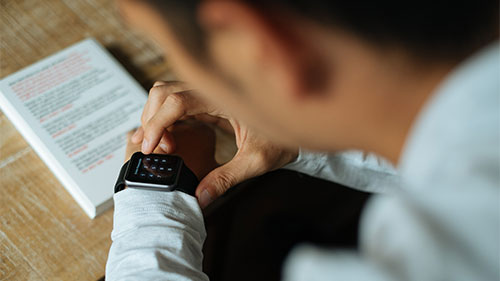Wearable technology is a fast growing market predicted to be worth $34 billion by 2020, according to an article by Forbes. There are so many different types of wearable tech now—watches, glasses, cameras, headsets, and more—that ignoring such a market would be a missed opportunity. While it may seem as though the publishing industry has no place in such tiny tech, research shows that there are ways that publishing companies can implement this technology to their benefit.
It may seem almost impossible for book publishers to find a way to utilize wearable tech. Nobody really wants to read an entire book on a screen that sits on a wristband, eyes straining to make out each word, with only a sentence per page turn. It would be slow, uncomfortable, and tedious. However, if publishers think beyond the book and think instead about the reader and the consumption of material, wearable tech could effectively be used. In 2015, The Guardian created an app, Moments, the first notable app of its kind. It is specifically tailored to the experience one has using wearable tech by enabling users access to small bits of information through breaking news notifications and personalized multimedia content that could later be accessed on a phone or tablet using the ‘save for later’ option. Book publishers could use the same method to reach readers.
The key to making apps for wearable tech is understanding that the media being consumed on these devices is often done quickly, in glances and brief bursts of attention. Because of this, media created for wearable tech must be designed for this quick and dirty type of intake. Wearable tech is not a stand-alone replacement for our current technology; instead it is meant to connect to other devices—it is simply one part of the bouquet of tech so many of us carry around on a daily basis. As such, publishers that are considering creating new apps and notification systems for wearable tech need to be in tandem with that which is already created for phones, tablets, and computers. Essentially following The Guardian’s lead, but tailoring it to the experience of the book buyer. While it’s unlikely anybody is going to read an entire book on their smart watch, they may read book blurbs and reviews—a preview of material, a brief introduction to a new read, available for them and perhaps even catered specifically to their liking. Many news apps allow users to set categories of interest, much like choosing a genre, and prioritizing specific content intended to catch the reader and direct them to a website. The Kindle app now sends notifications of new publications to its users, a function that would be easily transferable to a bite-sized snippet for smart watches. The Goodreads website also allows readers to pick genres that interest them and suggests new books that are similar to ones they have read. These applications could easily send suggestions to the wearable tech pieces.
While wearable tech is likely not going to revolutionize how publishers produce books, it might bring marketing strategies into a new era and allow publishers to reach greater audiences. This could be the future of consumer outreach for publishers.

